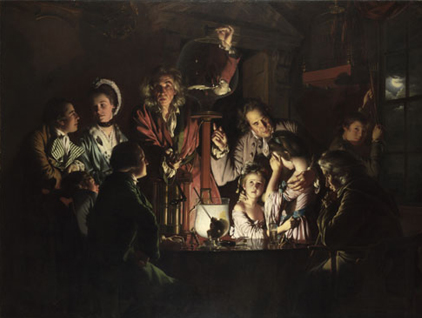Andrew Graham-Dixon on faith and rea-son in the paintings of Wright of Derby, currently showing at the Tate
Circa 1762-3, four members of the Markeaton Hunt demonstrate four ways to carry off the Markeaton Hunt costume - royal blue velvet coat, postbox-red waistcoat and yellow nankeen breeches - with the maxi-mum of dash. Francis Noel, Clarke Mundy and Harry Peckham opt for the three-quarters turn with left elbow out-thrust and come out with waistcoats blazing. Edward Becher Leacroft goes for the slightly pensive, non-chalant effect, hand thrust into his pocket, leaning up against a tastefully mouldering wall. Nicholas Heath outdoes them all by mounting a chair side-saddle, sporting his riding hat jauntily askew and flashing a tanta-lising glimpse of nankeen-clad thigh.
The Markeaton Hunt set were by all accounts fairly pleased with their portraits, by a Mr Joseph Wright. Not to be confused with Richard Wright from Liverpool, let alone Joseph Wright from America, he became Wright of Derby. The name has stuck, lending Wright and his works a certain provincial flavour which the Tate's current retrospective does much to dispel. Wright was something of a paradox. ''This cautious, hu-mourless, dedicated man from the English provinces'', as Benedict Nicholson described him in his pioneering monograph of the late 1960s, emerges as an artist extraordinarily attuned to the intellectual climate of his times.
Wright was, for the most part, a competent but essentially uninspired portrait painter. To find the source of his reputation, you have to walk through the show's first room, past those dashing young men in their hunting gear and some touchingly frail, china-doll portraits of short-lived eighteenth-century children and into the gallery given over to Wright's so-called ''Candlelight Pictures'' of the 1760s. Through the enveloping gloom that he seems to have taken from the Dutch Caravaggisti but may,...


